
“Boredom always precedes a period of great creativity.” — Robert M. Pirsig (American — Philosopher, Born: 1928)
Madame Bovary is the 1856 novel by French writer Gustave Flaubert. The main character Emma Bovary lives beyond her means in order to escape the banalities and emptiness of provincial life.
Emma is a beautiful farm girl, who was raised in a convent and always dreamed of the bliss of married life. However, when she marries the reliable, but dull Charles Bovary she becomes disillusioned. Hoping a child might bring her contentment, she is once again disappointed. She seeks excitement in the arms of other lovers and leaves for Paris, but neither satisfy her boredom.
As humans, we predominantly consider boredom as a negative state, but boredom can be reframed as a powerful catalyst to change, to invent and to explore, this phenomenon is known as “The Madame Bovary Effect”.
I grew up in the countryside of Ireland, where we had acres of fields and boxes of Lego and the two national TV channels (pre-Internet). My mother supplied plants, shrubs and flowers to national garden centres, while my father was a lecturer in horticulture. Once school was over, we were left to our own devices. We captured insects, explored the fields and played with our limited selection of toys. If we were bored, it drove us to be creative, to use our imagination and to do something new. I credit my childhood greatly for my curiosity and creativity, it is why you are reading this article, it is why I created the innovation show.
I started the innovation show while I was working as head of innovation for the national broadcaster in Ireland. The thing I struggled with most in the organisation was getting things done as quickly as used to in my previous role. I was consulted in a management meeting to dream up an idea for unique digital video content. I proposed the concept of the innovation show, (a showcase of new thinking for a new world), without hesitation, I was told it would never work. Bear in mind, I had only written an outline and I had nothing to do with it, it would need a presenter, which I had never imagined being.
As is the way of someone in my role, one gets used to not accepting a no without a fight. Hours later, I approached the radio department with the same idea. They immediately accepted it and enabled me to make it happen (for which I am ever grateful). I share all this to make the point that ultimately, I made the innovation show happen because I was unfulfilled in my job, the lack of getting things done bored me and boredom served as a catalyst to create something new.
The Innovation show has been an amazing gift and connects me and the show’s audience to Global thought leaders every week. One of the trends I have observed from talking to many of these leaders is the Benefit of Boredom.
The Benefit of Boredom
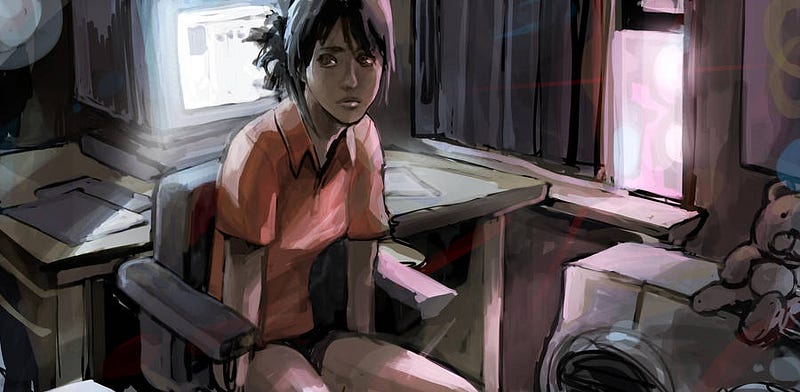
Baroness, Professor Susan Greenfield is a previous guest from the show and, a leading expert on the brain and the mind, a fellow of the Royal College of Physicians, a best-selling author and the recipient of 32 Honorary Degrees. During our chat on the show, Susan revealed boredom was “the biggest break she ever had”. Because her parents didn’t have very much, she was frequently on her own, “allowed to dream, to draw, to read and to think”. Susan states it is a very good thing to be bored as a kid because you have to make your own entertainment. One such instance of “free entertainment” involved a teenage Susan, (ably assisted by her three-year-old baby brother) dissecting a rabbit’s brain, obtained for free from the local Butcher and performed with her mother’s dress-making scissors.
Jim Doty MD is the most recent Innovation show (at time of publication). He is a Neurosurgeon, CEO, Entrepreneur, author and the director of the Center for Compassion and Altruism Research and Education (CCARE) at Stanford University, of which the Dalai Lama is a founding benefactor. Jim’s story, as told through his best-selling book, ‘Into the Magic Shop’ is a tale of how boredom can drive serendipity and serendipity can inspire dreams and dreams can drive action.
Jim grew up the son of an alcoholic father, paralysed and suicidal mother in very poor and uncertain conditions. Like Susan Greenfield, he was often left to his own devices. One of his passions as a youngster was magic and one day while cycling his paperboy bike he stumbled upon a magic shop. Having lost his precious fake magic thumb, he entered hoping to find an inexpensive replacement. 12-year-old Jim was greeted by a middle-aged mother named Ruth, who promised to teach him real magic if he would come back every day during the summer. Because she offered cookies and driven by boredom Jim cautiously accepted. That decision changed his life.
Susan taught Jim how to settle his mind, control his emotions, practice gratitude, forgiveness and manifestation. Susan effectively trained Jim in what we know today as mindfulness and affirmations. Owing to his impoverished upbringing and his boredom, Jim practised frequently every day. Jim went on to manifest a career as a Neurosurgeon, a CEO of a successfully floated (for $3bn) medical device company and an entrepreneur worth $85m. Today, he is the director of the Center for Compassion and Altruism Research and Education (CCARE) at Stanford University. As was his way, Jim manifested the Dalai Lama as a founding benefactor.
Are We Depriving Ourselves of Boredom?

“Work consists of whatever a body is obliged to do. Play consists of whatever a body is not obliged to do.” — Mark Twain
We all benefit from the improvements that technology can provide in our world, but just as we can suffer digital dementia (relying on our devices for tasks we previously did cognitively) our children can be deprived of both boredom and imagination. As many of you may remember, Lego used to be a less sophisticated offering. Many families would have a box of individual pieces and some base plates on which to build them. It was rare you would have an instruction manual, let alone an augmented reality option, a movie and a computer game, things were much simpler.
Having a manual for a creative opportunity like Lego seems like a contradiction, it feels too much like a pre-test to build some IKEA furniture. Lego represents creativity, but often the fun is taken out of it by the child adhering to instructions. I am always happier to see my sons using their imagination as the manual, it allows them to be free to “colour outside the lines” (as you do when you colour in pictures as a youngster.)
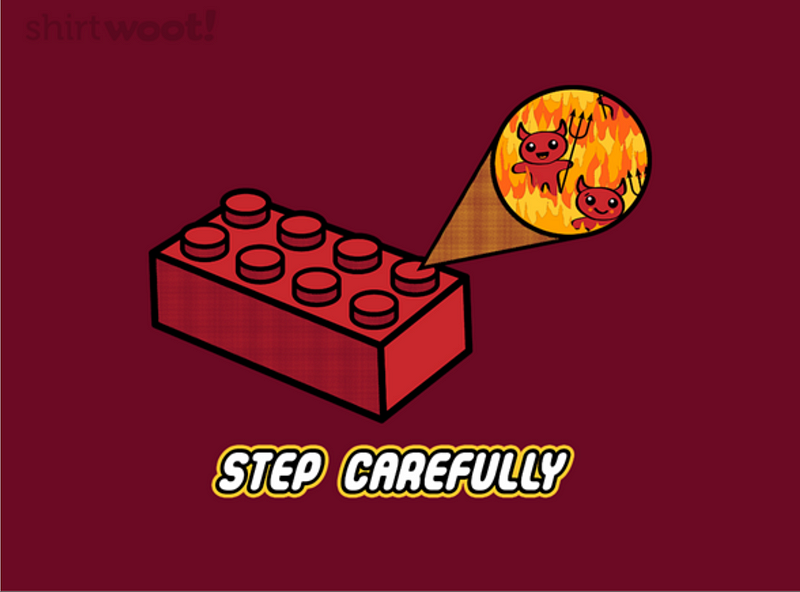
The first computer game I played was Space Invaders on a friend’s Atari. It was a rare but magical treat. What I remember most is how I would imagine the simple alien invaders as huge alien spacecraft akin to something from Star Wars or Battlestar Galactica, a far cry from the basic pixels that they were.
Today, computer game graphics are phenomenal. They are so well imagined, pre-imagined that they literally don’t leave anything to the imagination. The double whammy with computer games is because of their addictive quality, they use up valuable time, that might otherwise be available for imagination, curiosity and creativity. Couple the popularity of computer games with the prevalence of social media and on-demand TV and not much time is left for flexing our creative muscles.

Scheduling the Boredom Out
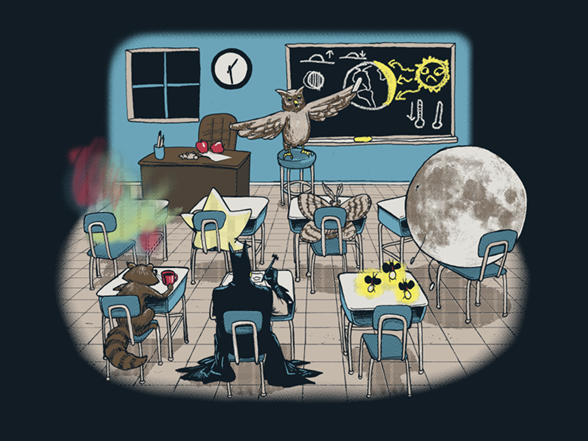
Tiger Parenting is a term that came to prominence after the publication of Amy Chua’s ‘Battle Hymn of the Tiger Mother’. The term describes parents who rule the household in an authoritarian way. Such parents focus on the high grades that their children must achieve. A typical tiger child will have every element of their day scheduled, leaving no time for the child to be… a child.
Many of these parents deprive their children of unstructured play and childhood opportunities to explore, to imagine, to simply be alone with one’s imagination.
B Curves
S curves are a great way to map lifecycles of business models and products. I have used them to map career paths in the past (“Why we should commit career “S”uicide”), but here I rebrand S curves as “B Curves”, a simple way to navigate the life cycle of your career, spare time and Boredom.
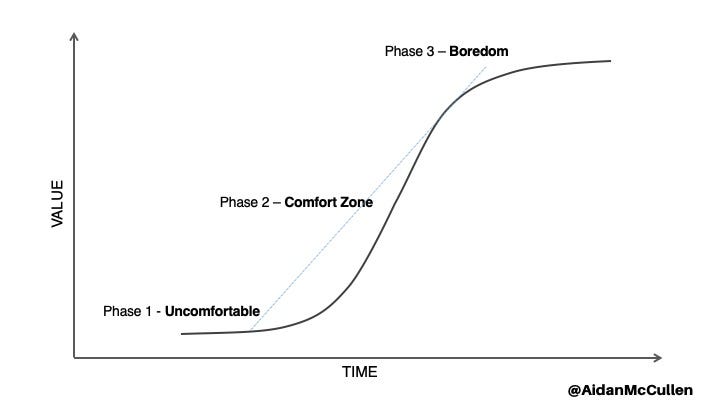
As you can see above, you begin out of your comfort zone, here you learn from your best teachers: experience and failure. As you rise up your curve you become more competent and start to plateau. In time, you can tell what time of year it is by the routine activities you execute. You are now entering the peak of your boredom.
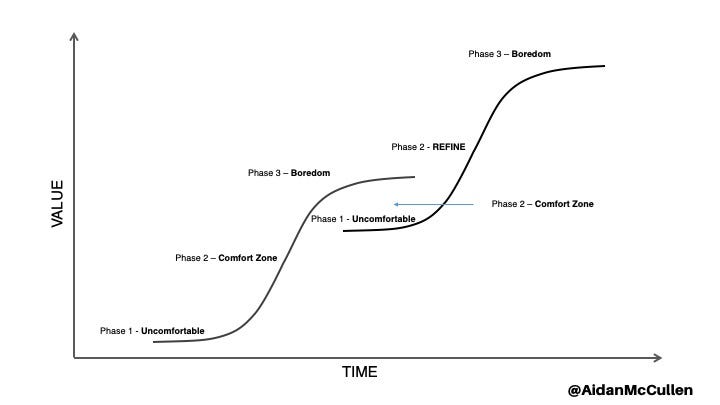
In life, as in business, we must be cognizant of where we sit on our B Curve. Everything in the world has a decay rate, an expiry date or a rebirth opportunity. Just as a forward-thinking business makes the decision to jump to a new curve, so too must we jump to a new curve in order to experience, to fail and to create anew.
In positive psychology, Flow is the term coined by Mihály Csíkszentmihályi, Flow is characterized by complete absorption in what one does, and a resulting loss in one’s sense of space and time. One of the key components of flow is the delicate balance between the familiar and the new.
We tend to perceive boredom as a negative thing, but it can be reframed as a signal to start something new. Boredom is the gateway to a new purpose. When you have a purpose you leverage the parts of yourself you’ve already explored: your preferences, values, passions, and strengths. It provides a map to your future life and guides you to make optimal use of who you are, and who you can become.
If you like this, you may like my article on “Functional Fixedness — Critical Thinking” here.
Thanks for Reading
As mentioned above, this episode of the Innovation Show is:
EP 142: Into the Magic Shop: A Neurosurgeon’s Quest to Discover the Mysteries of the Brain and the Secrets of the Heart with James R. Doty MD
Growing up in the high desert of California, Jim Doty was poor, with an alcoholic father and a mother chronically depressed and paralysed by a stroke.
Today, he is the director of the Center for Compassion and Altruism Research and Education (CCARE) at Stanford University, of which the Dalai Lama is a founding benefactor.
As a child, his life was at a dead end until at twelve he wandered into a magic shop looking for a plastic thumb. Instead, he met Ruth, a woman who taught him a series of exercises to ease his own suffering and manifest his greatest desires.
Ruth’s final mandate was that he keep his heart open and teach these techniques to others. She gave him his first glimpse of the unique relationship between the brain and the heart.
Doty would go on to put Ruth’s practices to work with extraordinary results. He achieved power and wealth that he could only imagine as a twelve-year-old.
However, he neglects Ruth’s most important lesson, to keep his heart open, with disastrous results. A spectacular charitable contribution that will virtually ruin him, changed his life. Part memoir, part science, part inspiration, and part practical instruction, Into the Magic Shop, shows us how we can fundamentally change our lives by first changing our brains and our hearts.
Have a listen:
Soundcloud https://lnkd.in/gBbTTuF
Spotify http://spoti.fi/2rXnAF4
iTunes https://apple.co/2gFvFbO
More about Jim here:
Meditations here:
http://intothemagicshop.com/exercises
Similar shows here:
http://www.theinnovationshow.io/2018/10/19/ep-126-a-life-worth-breathing-with-max-strom/